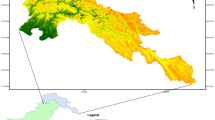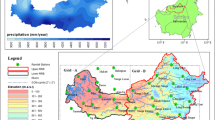Abstract
Global warming has considerably challenged the natural environment and livelihood conditions. Understanding potential future changes in critical climatic variables, such as temperature and precipitation, is important for regional agricultural and water resource management. This study proposes a new approach to the application of the Long Ashton Research Station Weather Generator (LARS-WG) in Coupled Model Intercomparison Project Phase 5 (CMIP5) emission scenarios and aims to test its applicability in cold areas and to evaluate the response of temperature and precipitation, in amount and form, under future warmer climate trends. Three stations in northeastern China are set as case sites, and 50 years of daily weather observations are used for model calibration and validation. Future synthetic time-series of daily precipitation and daily maximum and minimum temperatures is generated by the calibrated LARS-WG based on three Representative Concentration Pathway (RCP) scenarios with various radiative forcing levels of 14 general circulation models (GCMs) outputs for the periods 2041–2060 (2050s) and 2061–2080 (2070s). The results show that the CMIP5 scenarios can be successfully used in a LARS-WG model and that the model performs well in cold weather conditions to repeat the current status of the case sites; the model is able to provide downscaling analysis for future daily weather generation via updating calibrated model parameters based on various GCM outputs. A generally warming and wetting conversion would last into the future for the study sites, but there is great inconsistency among different GCMs. An ensemble approach is adopted with mean values of multi-GCMs to avoid the uncertainty associated with using a single GCM, based on which the changes in the form of precipitation are further estimated. As a result of the decrease in freezing conditions, although annual precipitation will continue to increase in the future, there will be relatively less annual snowfall, which will be primarily focused in deep winter. Such changes in snow cover conditions will potentially disturb the original rules of local overwintering agriculture. In addition, more intense and earlier snowmelt discharge and more rainfall in summer will latently impact the watershed hydrologic process. The influences of climate change are significant, and related projects for agricultural and water resource management should be of great concern in local decision-making.









Similar content being viewed by others
References
Ahmadzadeh Araji H, Wayayok A, Massah Bavani A, Amiri E, Abdullah AF, Daneshian J, Teh CBS (2018) Impacts of climate change on soybean production under different treatments of field experiments considering the uncertainty of general circulation models. Agric Water Manag 205:63–71. https://doi.org/10.1016/j.agwat.2018.04.023
Amin MZM, Islam T, Ishak AM (2014) Downscaling and projection of precipitation from general circulation model predictors in an equatorial climate region by the automated regression-based statistical method. Theor Appl Climatol 118:347–364. https://doi.org/10.1007/s00704-013-1062-2
Bannayan M, Paymard P, Ashraf B (2016) Vulnerability of maize production under future climate change: possible adaptation strategies. J Sci Food Agric 96:4465–4474. https://doi.org/10.1002/jsfa.7659
Chen H, Guo J, Zhang Z, Xu C-Y (2013) Prediction of temperature and precipitation in Sudan and South Sudan by using LARS-WG in future. Theor Appl Climatol 113:363–375. https://doi.org/10.1007/s00704-012-0793-9
Conway D, van Garderen EA, Deryng D, Dorling S, Krueger T, Landman W, Lankford B, Lebek K, Osborn T, Ringler C, Thurlow J, Zhu T, Dalin C (2015) Climate and southern Africa’s water-energy-food nexus. Nat Clim Chang 5:837–846. https://doi.org/10.1038/nclimate2735
Dumont B, Basso B, Bodson B, Destain JP, Destain MF (2016) Assessing and modeling economic and environmental impact of wheat nitrogen management in Belgium. Environ Model Softw 79:184–196. https://doi.org/10.1016/j.envsoft.2016.02.015
Fenta Mekonnen D, Disse M (2018) Analyzing the future climate change of Upper Blue Nile River basin using statistical downscaling techniques. Hydrol Earth Syst Sci 22:2391–2408. https://doi.org/10.5194/hess-22-2391-2018
Fezzi C, Harwood AR, Lovett AA, Bateman IJ (2015) The environmental impact of climate change adaptation on land use and water quality. Nat Clim Chang 5:255–260. https://doi.org/10.1038/nclimate2525
Gao X, Shi Y, Giorgi F (2011) A high resolution simulation of climate change over China. Sci China Earth Sci 54:462–472. https://doi.org/10.1007/s11430-010-4035-7
Giorgi F, Lionello P (2008) Climate change projections for the Mediterranean region. Glob Planet Chang 63:90–104. https://doi.org/10.1016/j.gloplacha.2007.09.005
Grafton RQ, Pittock J, Davis R, Williams J, Fu G, Warburton M, Udall B, McKenzie R, Yu X, Che N, Connell D, Jiang Q, Kompas T, Lynch A, Norris R, Possingham H, Quiggin J (2013) Global insights into water resources, climate change and governance. Nat Clim Chang 3:315–321. https://doi.org/10.1038/nclimate1746
Hassan Z, Shamsudin S, Harun S (2014) Application of SDSM and LARS-WG for simulating and downscaling of rainfall and temperature. Theor Appl Climatol 116:243–257. https://doi.org/10.1007/s00704-013-0951-8
Hijmans RJ, Cameron SE, Parra JL, Jones PG, Jarvis A (2005) Very high resolution interpolated climate surfaces for global land areas. Int J Climatol 25:1965–1978. https://doi.org/10.1002/joc.1276
Hussain M, Yusof KW, Mustafa MRU, Mahmood R, Jia S (2018) Evaluation of CMIP5 models for projection of future precipitation change in Bornean tropical rainforests. Theor Appl Climatol 134:423–440. https://doi.org/10.1007/s00704-017-2284-5
Kim HK, Parajuli PB, Filip To SD (2013) Assessing impacts of bioenergy crops and climate change on hydrometeorology in the Yazoo River Basin, Mississippi. Agric For Meteorol 169:61–73. https://doi.org/10.1016/j.agrformet.2012.10.007
Kumar D, Arya DS, Murumkar AR, Rahman MM (2014) Impact of climate change on rainfall in northwestern Bangladesh using multi-GCM ensembles. Int J Climatol 34:1395–1404. https://doi.org/10.1002/joc.3770
Ma C, Pan S, Wang G, Liao Y, Xu Y-P (2016) Changes in precipitation and temperature in Xiangjiang River Basin. China Theor Applied Climatol 123:859–871. https://doi.org/10.1007/s00704-015-1386-1
Mahat V, Anderson A (2013) Impacts of climate and catastrophic forest changes on streamflow and water balance in a mountainous headwater stream in southern Alberta. Hydrol Earth Syst Sci 17:4941–4956. https://doi.org/10.5194/hess-17-4941-2013
McNutt M (2013) Climate change impacts. Science 341:435–435. https://doi.org/10.1126/science.1243256
Naderi M, Raeisi E (2016) Climate change in a region with altitude differences and with precipitation from various sources, South-Central Iran. Theor Appl Climatol 124:529–540. https://doi.org/10.1007/s00704-015-1433-y
Pervez MS, Henebry GM (2014) Projections of the Ganges–Brahmaputra precipitation—downscaled from GCM predictors. J Hydrol 517:120–134. https://doi.org/10.1016/j.jhydrol.2014.05.016
Qin XS, Lu Y (2014) Study of climate change impact on flood frequencies: a combined weather generator and hydrological modeling approach. J Hydrometeorol 15:1205–1219. https://doi.org/10.1175/jhm-d-13-0126.1
Reddy KS, Kumar M, Maruthi V, Umesha B, Vijayalaxmi RC (2014) Climate change analysis in southern Telangana region, Andhra Pradesh using LARS-WG model. Curr Sci 107:54–62
Sanchez E, Gallardo C, Gaertner MA, Arribas A, Castro M (2004) Future climate extreme events in the Mediterranean simulated by a regional climate model: a first approach. Glob Planet Chang 44:163–180. https://doi.org/10.1016/j.gloplacha.2004.06.010
Sarkar J, Chicholikar JR, Rathore LS (2015) Predicting future changes in temperature and precipitation in arid climate of Kutch, Gujarat: analyses based on LARS-WG model. Curr Sci 109:2084–2093
Semenov MA, Barrow EM (1997) Use of a stochastic weather generator in the development of climate change scenarios. Clim Chang 35:397–414. https://doi.org/10.1023/a:1005342632279
Semenov MA, Stratonovitch P (2015) Adapting wheat ideotypes for climate change: accounting for uncertainties in CMIP5 climate projections. Clim Res 65:123–139
Solow AR (2015) Extreme weather, made by us? Science 349:1444–1445. https://doi.org/10.1126/science.aad2132
Stevens B, Giorgetta M, Esch M, Mauritsen T, Crueger T, Rast S, Salzmann M, Schmidt H, Bader J, Block K, Brokopf R, Fast I, Kinne S, Kornblueh L, Lohmann U, Pincus R, Reichler T, Roeckner E (2013) Atmospheric component of the MPI-M earth system model: ECHAM6. J Adv Model Earth Syst 5:146–172. https://doi.org/10.1002/jame.20015
Tripathi S, Srinivas VV, Nanjundiah RS (2006) Downscaling of precipitation for climate change scenarios: a support vector machine approach. J Hydrol 330:621–640. https://doi.org/10.1016/j.jhydrol.2006.04.030
Vallam P, Qin XS (2018) Projecting future precipitation and temperature at sites with diverse climate through multiple statistical downscaling schemes. Theor Appl Climatol 134:669–688. https://doi.org/10.1007/s00704-017-2299-y
Wilby RL, Dawson CW, Barrow EM (2002) SDSM—a decision support tool for the assessment of regional climate change impacts. Environ Model Softw 17:147–159
Zarghami M, Abdi A, Babaeian I, Hassanzadeh Y, Kanani R (2011) Impacts of climate change on runoffs in East Azerbaijan, Iran. Glob Planet Chang 78:137–146. https://doi.org/10.1016/j.gloplacha.2011.06.003
Zhang XC (2005) Spatial downscaling of global climate model output for site-specific assessment of crop production and soil erosion. Agric For Meteorol 135:215–229. https://doi.org/10.1016/j.agrformet.2005.11.016
Acknowledgments
The authors acknowledge the developer of the LARS-WG model for access to software and license agreement. The data used for model application were provided by the Data Center for Resources and Environmental Sciences, Chinese Academy of Sciences (RESDC) (http://www.resdc.cn), and the China Meteorological Data Service Center (CMDC) (http://data.cma.cn).
Funding
The study is financially supported by the innovation team training plan of the Tianjin Education Committee (TD13-5073), the National Natural Science Foundation of China (No. 41372373), the Opening Fund of Tianjin Key Laboratory of Water Resources and Environment (117-YF11700102), and the Science & Technology Development Fund of Tianjin Education Commission for Higher Education (2018KJ160).
Author information
Authors and Affiliations
Corresponding author
Additional information
Publisher’s note
Springer Nature remains neutral with regard to jurisdictional claims in published maps and institutional affiliations.
Electronic supplementary material
ESM 1
(RAR 3905 kb)
Rights and permissions
About this article
Cite this article
Sha, J., Li, X. & Wang, ZL. Estimation of future climate change in cold weather areas with the LARS-WG model under CMIP5 scenarios. Theor Appl Climatol 137, 3027–3039 (2019). https://doi.org/10.1007/s00704-019-02781-4
Received:
Accepted:
Published:
Issue Date:
DOI: https://doi.org/10.1007/s00704-019-02781-4




